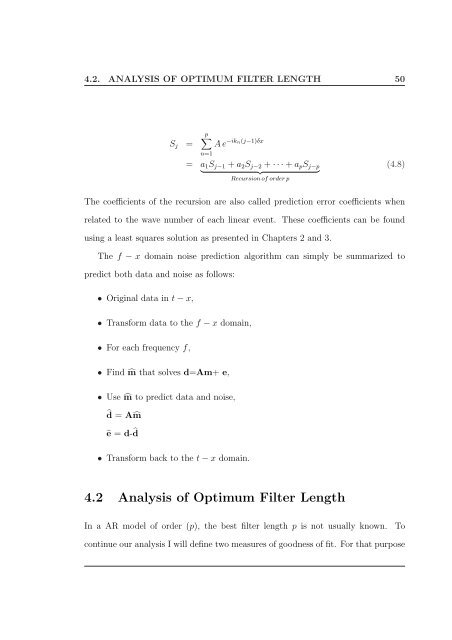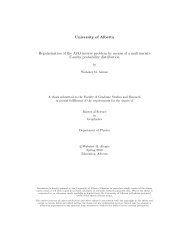Soner Bekleric Title of Thesis: Nonlinear Prediction via Volterra Ser
Soner Bekleric Title of Thesis: Nonlinear Prediction via Volterra Ser
Soner Bekleric Title of Thesis: Nonlinear Prediction via Volterra Ser
You also want an ePaper? Increase the reach of your titles
YUMPU automatically turns print PDFs into web optimized ePapers that Google loves.
4.2. ANALYSIS OF OPTIMUM FILTER LENGTH 50<br />
Sj =<br />
p<br />
A e<br />
n=1<br />
−ikn(j−1)δx<br />
= a1Sj−1 + a2Sj−2 + · · · + apSj−p<br />
<br />
Recursion <strong>of</strong> order p<br />
(4.8)<br />
The coefficients <strong>of</strong> the recursion are also called prediction error coefficients when<br />
related to the wave number <strong>of</strong> each linear event. These coefficients can be found<br />
using a least squares solution as presented in Chapters 2 and 3.<br />
The f − x domain noise prediction algorithm can simply be summarized to<br />
predict both data and noise as follows:<br />
• Original data in t − x,<br />
• Transform data to the f − x domain,<br />
• For each frequency f,<br />
• Find m that solves d=Am+ e,<br />
• Use m to predict data and noise,<br />
d = Am<br />
e = d- d<br />
• Transform back to the t − x domain.<br />
4.2 Analysis <strong>of</strong> Optimum Filter Length<br />
In a AR model <strong>of</strong> order (p), the best filter length p is not usually known. To<br />
continue our analysis I will define two measures <strong>of</strong> goodness <strong>of</strong> fit. For that purpose









